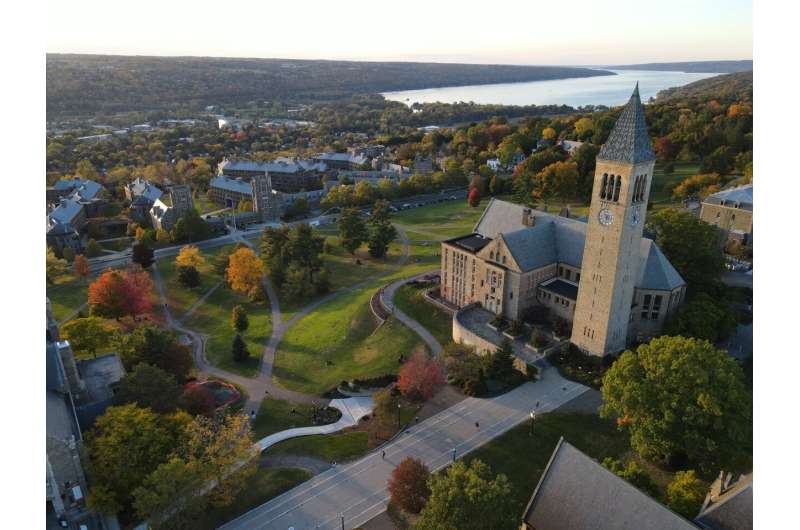This article has been reviewed according to Science X's editorial process and policies. Editors have highlighted the following attributes while ensuring the content's credibility:
fact-checked
trusted source
written by researcher(s)
proofread
How the pandemic permanently altered college towns

Universities are more than just halls of learning; they are vibrant ecosystems and often the beating heart of the towns they reside in. Their reach goes beyond academia and plays a significant role in shaping the local economies of North American college towns.
However, the COVID-19 pandemic affected college towns profoundly. In doing so, the pandemic highlighted the complex relationship between universities and their host communities.
College towns can be classified into two distinct types in North America. The first category includes towns with a strong academic ethos. In these cities, universities are the lifeblood flowing through their communities. Examples of this group include Ithaca, N.Y.; Manhattan, Kan.; and Kingston, Ont..
The second category features academic powerhouses nestled within capitals or major cities. These universities are essential components of the broader social, cultural and economic landscape, rather than being the defining feature.
Boston; Los Angeles; Toronto; and Montréal are examples of this group. These cities combine vibrant academic atmospheres with big-city life, and they consistently rank among the top choices for students to live.
Pre-pandemic college towns
Before the COVID-19 pandemic, the constant influx of students, faculty, families and alumni in college towns created a consistent economic rhythm. Local businesses, ranging from cozy cafés to quaint bookstores to major retailers, thrived on the foot traffic from college students.
But the pandemic changed all this. Our recent study conducted an analysis of foot traffic data from universities situated in 38 small and midsize cities in the U.S., along with 157 Walmart and Target stores in these towns, from 2018 to 2020.
Our findings indicate a positive correlation between university foot traffic and store visits. Stores that were closer to universities benefited more from this relationship. In addition, stores in college towns that offered a wider range of commuting options, especially eco-friendly ones like public transit and biking, saw even greater advantages from their proximity to universities.
These findings emphasize the importance of improving accessibility for retailers looking to make the most of university foot traffic. Such measures not only bolster local business, but also highlight the wider environmental and communal benefits of adopting sustainable practices.
Post-pandemic college towns
The pandemic had an immediate and devastating impact on college towns. Universities closed campuses, shifted to remote learning and cancelled in-person events, causing these lively communities to become shadows of their former selves.
The economic repercussions were severe. Without a steady stream of visitors, local businesses experienced a sharp decline in revenue. Those located farther from the university faced even greater challenges, as the increased distance resulted in less in-store visits.
However, our research revealed that a broad range of commuting options continued to have a positive effect on the connection between university visits and store visits. In fact, this effect actually intensified.
Businesses, despite being hit hard by the disruptions, refused to succumb without a fight and began to adapt and innovate. They embraced online sales, hosted virtual events and provided contactless deliveries.
Universities also showcased remarkable resilience and innovation. They transitioned to remote and hybrid teaching and virtual tours and events. They also supported students and local businesses through external partnerships, as evidenced by initiatives like campus robot food delivery programs.
These adaptations did more than just address immediate challenges—they also revealed untapped innovation potential, redefined the relationship between education and local businesses, and fundamentally transformed the nature of connectivity and interactivity in college towns.
Thriving, not surviving
The pandemic, despite its chaos, shed light on the importance of university visits in driving local economies. It also underscored the need for local businesses to tailor consumer experiences to the post-pandemic landscape by integrating physical and digital experiences. This encompasses everything from self-service technology to express delivery services.
Local governments and universities must play a crucial role in post-pandemic economic recovery by improving public transit systems and bike-sharing programs. A deeper collaboration between these entities is vital for boosting student enrolments and reinvigorating local economic activity. This should go beyond improving marketing and campus amenities and work on making higher education more accessible and affordable.
These initiatives are not just about recovery; they are a commitment to a more resilient future. The economic vitality of college towns is tied to the ebb and flow of university life. While the COVID-19 pandemic exposed the fragility of this relationship, it also revealed a path forward characterized by adaptability, innovation and an unyielding sense of community.
By embracing a future that blends the physical with the digital, and tradition with innovation, college towns are not just surviving; they are redefining what it means to thrive.
Provided by The Conversation
This article is republished from The Conversation under a Creative Commons license. Read the original article.![]()




















